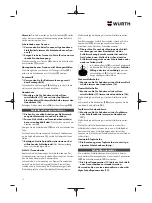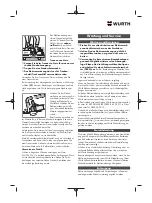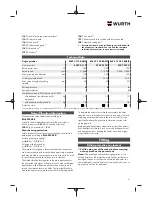
23
Quick-clamping nut
To change the abrasive tool easily without having to use any
additional tools, you can use the quick-clamping nut
(13)
in-
stead of the clamping nut
(12)
.
r
The quick-clamping nut
(13)
may be used only
for grinding or cutting discs.
Only use quick-clamping nuts (13)
that are in good
working order and not damaged.
When screwing on, make sure that the printed
side of the quick-clamping nut
(13)
is not facing the
grinding disc; the arrow must be pointing towards
the index mark (23).
(23)
Press the spindle lock button
(1)
to lock the grinding
spindle. To tighten the quick-
clamping nut, turn the grind-
ing disc firmly clockwise.
If the quick-clamping nut has
been attached correctly and
is not damaged, you can
loosen it by hand by turning
the knurled ring anticlock-
wise.
Never loosen a
tight quick-clamping
nut with pliers. Always
use the combination
wrench.
Insert the combin-
ation wrench as shown in
the figure.
Approved abrasive
tools
You can use all the abrasive tools mentioned in these operat-
ing instructions.
The permissible speed [rpm] or the circumferential speed [m/
s] of the abrasive tools used must at least match the values
given in the table.
It is therefore important to observe the permissible
rota-
tional/circumferential speed
on the label of the abras-
ive tool.
max. [mm]
[mm]
D
b
d
[rpm]
[m/s]
115
125
7
7
22.2
22.2
11,000
11,000
80
80
D
115
125
–
–
–
–
11,000
11,000
80
80
D
b
d
70
75
30
30
M10
M14
11,000
11,000
45
45
D
d
82
–
M14
11,000
80
r
Pull the plug out of the socket before carrying
out any work on the power tool.
The machine head can be
rotated in 90° increments. In
this way, the on/off switch
can be brought into a more
favourable handling position
for particular applications,
e.g. for left-handed tool
users.
Completely unscrew the four
screws. Rotate the machine
head carefully,
without removing it from the housing
,
into the new position. Screw in and retighten the four screws.
Dust/chip extraction
The dust from materials such as lead paint, some types of
wood, minerals and metal can be harmful to human health.
Touching or breathing in this dust can trigger allergic reactions
and/or cause respiratory illnesses in the user or in people in
the near vicinity.
Certain dusts, such as oak or beech dust, are classified as car-
cinogenic, especially in conjunction with wood treatment ad-
ditives (chromate, wood preservative). Materials containing
asbestos may only be machined by specialists.
– Use a dust extraction system that is suitable for the material
wherever possible.
– Provide good ventilation at the workplace.
– It is advisable to wear a P2 filter class breathing mask.
The regulations on the material being machined that apply in
the country of use must be observed.
















































